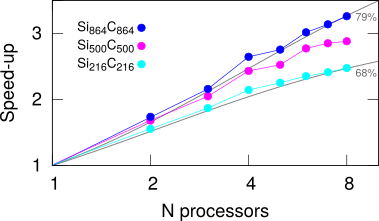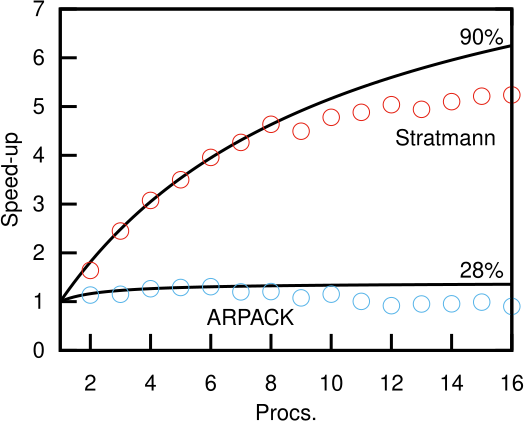Benchmarking and scalability#
If you want results more rapidly, it is important to work out approximately how many compute processors to use to calculate your problem (particularly if there is a per-processor cost for using that resource). Just using the maxium available number of cores may be inefficient, so benchmarking a “typical” example of your calculation can help to get results faster and avoid wasting resources.
Your test examples should be large enough to require more than a trivial amount of computer time to be run due to inaccuracies in timing short calculations:
* Random variations in processor/network load can produce noise in
the times
* You might want to run your tests several times on the same
platform and average the timings
If your aim is to run large problems, you can use tests on small “toy” versions and estimate resource requirement for the big cases to be feasibly simulated.
Timers#
DFTB+ has an internal timer for various significant parts of its calculations. This can be enabled by adding the following option to the input:
Options {
TimingVerbosity = 2
}
This will activate the timers for the most significant stages of a calculation. Higher values increase the verbosity of timing, while a value of -1 activates all available timers.
The typical output of running the code with timers enabled for a serial calculation will end with lines that look something like
--------------------------------------------------------------------------------
DFTB+ running times cpu [s] wall clock [s]
--------------------------------------------------------------------------------
Pre-SCC initialisation + 3.46 ( 5.8%) 3.45 ( 5.8%)
SCC + 47.34 ( 79.6%) 47.34 ( 79.6%)
Diagonalisation 44.79 ( 75.3%) 44.79 ( 75.3%)
Density matrix creation 2.21 ( 3.7%) 2.21 ( 3.7%)
Post-SCC processing + 8.68 ( 14.6%) 8.68 ( 14.6%)
Energy-density matrix creation 0.55 ( 0.9%) 0.55 ( 0.9%)
Force calculation 7.74 ( 13.0%) 7.74 ( 13.0%)
Stress calculation 0.94 ( 1.6%) 0.94 ( 1.6%)
--------------------------------------------------------------------------------
Missing + 0.00 ( 0.0%) 0.00 ( 0.0%)
Total = 59.48 (100.0%) 59.47 (100.0%)
--------------------------------------------------------------------------------
This shows the computing time (cpu) and real time (wall clock) times of major parts of the calculation.
An alternative method to obtain total times is by using the built-in shell command time when running the DFTB+ binary
time dftb+ > output
In the above example, at the termination of the code timings will be printed:
real 0m59.518s
user 0m59.430s
sys 0m0.092s
More advanced timing is possible by using profiling tools such as gprof.
Examples#
Spin locks#
[Input: recipes/parallel/spinlock/]
The idealised performance of Amdahl’s law assumes that the parallel parts of the calculation can be spread over arbitrarily large numbers of computing units without any contention between them.
In reality, finite problems can only be meaningfully broken down to some lower limit of sub-problem size. Similarly, operations that require different processes to cooperate can find them waiting for each other to complete (an example of spinlock/contention behaviour), then release the resulting data with the latency of moving it around between different levels of the memory hierarchy.
This leads in practice to the performance of a calculation actually degrading if too many processors are requested. This will depend on the particular hardware and libraries being used.
Below are examples for an excited state calculation of a C60 molecule using OpenMP parallelism. See the Linear response excitations section for details about this type of calculation.
In this example, being too greedy in requesting processes leads to worse parallelism (or even a slower calculation):
As you can see, the ARPACK solver is not a very parallel calculation (28%). There is some marginal improvement in throughput up to ~4 processes. But, beyond this point it rapidly becomes not just inefficient, but counter-productive to add more processors to try and get your results faster. The Stratmann solver is better (90% parallel in this case), but even there, above ~8 processors, the parallelism degrades.
Of course, this doesn’t actually tell you which solver is faster to get the answer to the problem, only how they scale. To find this out requires comparing the actual wall-clock times:
Procs |
ARPACK |
Stratmann |
1 |
38.31s |
106.96s |
6 |
29.32s |
27.03s |
8 |
31.76s |
23.07s |
As you can see, on one processor the ARPACK solver is actually faster (the Stratmann solver is currently optimized for finding only a few excited states, and this example calculates 100). By 6 processors (the last point ARPACK shows any speed-up for this example), this speed advantage is lost while Stratmann continues getting faster (being ~1.7x faster to get the solution than serial ARPACK when using 8 processors,).
The above data was generated from the Post-SCC processing wall clock time printed by DFTB+, which is dominated by the excited state calculation in this case. The number of Open MP threads is varied with the relevant shell variable:
export OMP_NUM_THREADS=1
dftb+
export OMP_NUM_THREADS=4
dftb+
You can also use the system timer time dftb+, but the internal timers produce a more finegrained output of timings
DFTB+ running times cpu [s] wall clock [s]
--------------------------------------------------------------------------------
Global initialisation + 0.00 ( 0.0%) 0.01 ( 0.0%)
SCC + 0.15 ( 0.4%) 0.19 ( 0.5%)
Diagonalisation 0.13 ( 0.3%) 0.18 ( 0.5%)
Post-SCC processing + 38.23 ( 99.6%) 38.31 ( 99.5%)
--------------------------------------------------------------------------------
Missing + 0.00 ( 0.0%) 0.00 ( 0.0%)
Total = 38.38 (100.0%) 38.52 (100.0%)
--------------------------------------------------------------------------------
Distributed memory parallelism#
This section coming soon!
Topics to be discussed:
Parallel scaling of simple examples.
Parallel efficiency.
Use of the Groups keyword in DFTB+ to improve scaling and efficiency for calculations with spin polarisation and/or k-points.
Effects of latency on code performance.
GPU computing#
Description coming soon!


